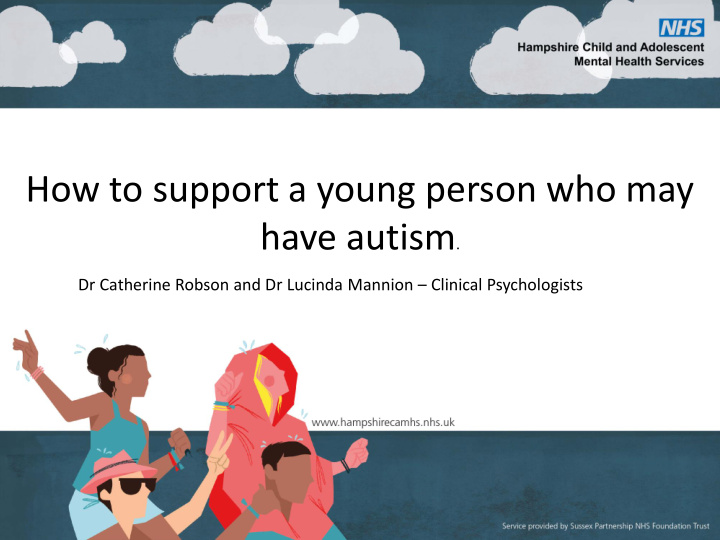



How to support a young person who may have autism . Dr Catherine Robson and Dr Lucinda Mannion – Clinical Psychologists
• National Autistic Society www.autism.org.uk • Hampshire Autistic Society www.autismhampshire.org.uk
Restricted / repetitive Social communication / behaviour: interaction: Repetitive Social reciprocity speech/behaviour Non-verbal Insistence on sameness communication Restricted interests Relationships Sensory aspects
What this might look like Difficulties/Differences in: • Difficulties with friendships – making, keeping, understanding • Not “getting the social context”, overwhelmed by social demands, not understanding social rules • Noticing objects and facts rather than thoughts, feelings, intentions • Too much/too little talking, unusual ways of talking • Difficulty listening, taking turns, having conversations, understanding what people mean. • Use of non-verbal communication e.g. gesture, facial expression • Understanding and communicating about emotions • Difficulty predicting what is going to happen, what could happen, what the options are • Difficulty predicting other people or understanding their intentions; Not understanding how others think or feel • Unusual, intense or excessive interests • Fixed routines and ways of doing things; “my way” • Sensory interests or sensitivities – noises, lighting, feelings of clothes, busy places
• We use DSM-5 criteria • Diagnostic category is Autistic Spectrum Disorder (ASD) but we usually refer to Autistic Spectrum Condition (ASC) – they are the same. • (No longer have Asperger’s Syndrome as a diagnosis – but look up the literature! Lots of good books that are about Asperger’s )
We should aim for children and adults with autistic spectrum conditions to be proud and happy with who they are. A diagnosis can help people become aware of, and make plans for, both their qualities and difficulties
Legislation Reasonable adjustments Autism Act Equality Act Education Act All mention the duty to implement ‘Reasonable Adjustments’ so that those with a disability are not disadvantaged in a variety of settings from education to employment. Autism is a ‘hidden’ disability and so the duty is often not fulfilled .
Communication • Clear and unambiguous • Concrete, not abstract • Make sure the words match the tone, facial expression, gesture. • Short, one instruction at a time • Tell them what to do, not what not to do • Use visual means to support – whatever their ability • Use concrete props • Allow time for processing • Books and facts • Scientific language/metaphors
Increase predictability and routine • Change= unpredictable=scary • Use visual timetables (calendars, diaries…) • Daily routine when can look at timetable and plan for changes - ?daily check in at school • If something changes, let them know. • Talk through what they can expect in new situations. • Plan and prepare – visit, look at pictures, plan coping strategies. • Keep a notebook with answers to questions – refer back • Use little normal routines to add security e.g. what happens at mealtimes, bedtimes • Use timers and countdowns • Plan for “waiting” – unstructured time can be overwhelming
Routine, timetable, agenda
Support social understanding and inclusion (1) • Help them recognise, name and learn about their emotions • Emotional literacy programs • Scaling – the Incredible Five Point Scale • Use their special interests – to find safe social opportunities or to help explain things (e.g. what would Iron Man do? What was he thinking?) • Seek supportive, structured social spaces - lunchtime clubs? Library? • Find jobs and tasks to show their skills and help others. • Allow space for a “social break” - downtime
Example of Five Point Scale
Support social understanding and inclusion (2) • Social stories – helps a child to understand situations that might be causing them difficulties, and gives them ways of managing it. • The work of Carol Gray • www.carolgraysocialstories.com • Comic Strip Conversations – a visual way to explore situations and what other people might be thinking or feeling • Can lead to a better understanding of motivations, or the reason something happened the way it did • May lead to a social story to help deal with a situation • Talk through real life examples or situations on TV (Big Bang Theory?) • Get them to ask the perspective or observe a friend
Sensory sensitivities • Some unusual behaviours can be linked to children trying to manage their sensory sensitivities • Pay attention to the environment - adjust • Noise, lighting, busy-ness etc • Concept of stalling and revving – some children may need more or less stimulation to help them function at their best • Oral, tactile, olfactory, touch, auditory, proprioceptive, vestibular
Sensory Intervention • Assessment is OT led • Intervention to integrate sensory experience, desensitise or get stimulation appropriately as seen as necessary • Planning: • be aware. Look at the environment to see if it is creating difficulties. Can you change anything? • be creative. Think of some positive sensory experiences. • be prepared. Tell the person about possible sensory stimuli they may experience in different environments. • Strategies: • Brushing, therapeutic listening, movement breaks, deep pressure, chews, move n sit cushions, fiddle toys, suck/ blow activities
Emotional Toolbox Promote coping strategies and abilities in all areas: • Physical • Relaxation • Social • Communication • Thinking • Sensory
Recommend
More recommend